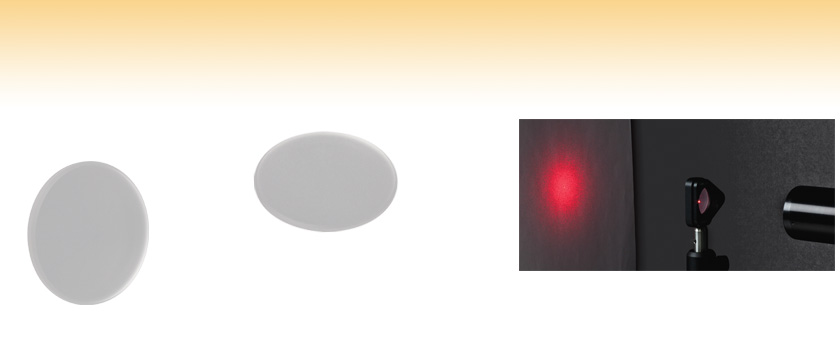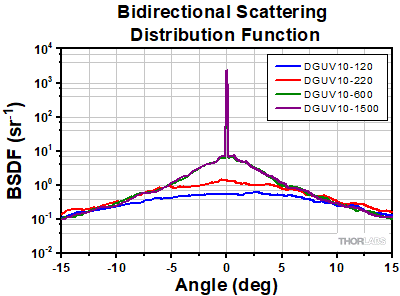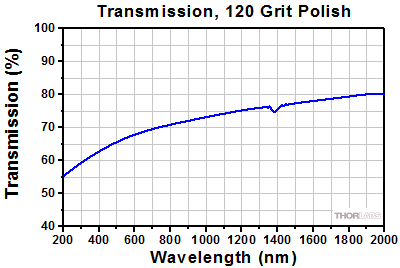UV Fused Silica Ground Glass Diffusers

- Superior Transmission in UV Range
- Offered in 120, 220, 600, and 1500 Grit Polishes
- Polished for Greater Uniformity than Sand Blasting
DGUV10-120
DGUV10-220
Application Idea
DGUV10-600 Mounted in KB1P Quick-Release Mount

Please Wait
Features
- Ø1" Round Diffusers
- UV Fused Silica Substrate
- Greater than 90% Transmission Above 225 nm
- Gaussian-Like Spatial Profile
- Clear Aperture: >90% Diameter
Thorlabs' UV Fused Silica Ground Glass Diffusers can be used in a variety of applications requiring a diffuse Gaussian-like distribution. Unlike our diffusers based on N-BK7 substrates, UV fused silica is highly transmissive at wavelengths below 350 nm. In addition, UV fused silica exhibits virtually no laser-induced fluorescence (as measured at 193 nm), making it an ideal choice for applications in a range spanning the ultraviolet to the near infrared. See the Comparison tab for a side-by-side comparison of the wavelength-dependent transmission of N-BK7 and UV fused silica.
These diffusers feature 120, 220, 600, or 1500 grit polishes. Our polishing process results in surfaces with significantly greater uniformity than those of sandblasted diffusers. The various grits provide a range from fine to coarse scattering. A finer grit (e.g. 1500) has a small diffusion pattern, while a coarser grit (e.g. 120) will have a larger diffuser pattern. See Figure 1.1 to compare the performance of our diffusers and the Graphs tab to see individual graphs for each diffuser, as well as measurement details.

Click to Enlarge
Click to Download Raw Data
Figure 1.1 See the Graphs Tab for Information about BSDF Measurement
When mounting the diffusers, the grit polished side should face away from the source. Thorlabs offers fixed lens mounts to hold these diffusers.
If transmission in the ultraviolet range is not necessary for your application, please consider our line of N-BK7 Ground Glass Diffusers.
| Diffuser Selection Guide | |||
|---|---|---|---|
| Ground Glass Diffusers | |||
| Type | Material | Mounting, Coating | Operating Wavelength |
| Standard Diffusers | N-BK7 Substrate | Unmounted, Uncoated | 350 nm - 2.0 μm |
| Unmounted, AR Coated | 350 nm - 700 nm 650 nm - 1050 nm |
||
| Mounted, Uncoated | 350 nm - 2.0 µm | ||
| UVFS Substrate | Unmounted, Uncoated | 185 nm - 2.0 µm | |
| Diffuse Reflectors | N-BK7 Substrate | Unmounted, UV-Enhanced Aluminum Coated |
250 nm - 450 nm |
| Unmounted, Protected Silver Coated | 450 nm - 20 µm | ||
| Unmounted, Protected Gold Coated | 800 nm - 20 µm | ||
| Alignment Disks | |||
| Engineered Diffusers®* | |||
| Type | Material | Mounting, Coating | Operating Wavelength |
| Glass Diffusers | UVFS Substrate | Unmounted and Mounted, Uncoated | 400 nm - 700 nm |
| Polymer Diffusers | ZEONOR Substrate | Unmounted and Mounted, Uncoated | 400 nm - 700 nm |
| Diffuser Kits | |||
*Engineered Diffusers® is a registered trademark of VIAVI Solutions, Inc.
| Common Specifications | |
|---|---|
| Diameter | 1.00" |
| Thickness | 2.0 mm |
| Clear Aperture | >90% Diameter |
| Surface Flatness of Smooth Side (@ 633 nm) |
<λ |
| Surface Quality of Smooth Side | 80-50 Scratch-Dig |
| Parallelism | <3 arcmin |
| Item # | Grit |
|---|---|
| DGUV10-120 | 120 |
| DGUV10-220 | 220 |
| DGUV10-600 | 600 |
| DGUV10-1500 | 1500 |
Please note that the transmission values are affected by the manner in which the data is collected. An integrating sphere is used along with a spectrometer, and as the grit values get smaller the light is more dispersed, making it difficult to collect all of the light into the spectrometer. Therefore, lower grit values will appear to have a lower transmission.
Bidirectional Scattering Distribution Function Graphs
This data was taken by directing a HeNe laser at a diffuser and collecting the light with a receiver that was rotated around the diffuser to measure the angle-resolved scatter (ARS). The bidirectional scattering distribution function (BSDF), which is found by dividing the ARS by the cosine of the angle between the input beam and the receiver, measures the amount of scattering that occurs after light permeates the diffuser. The X axis of these graphs is the angle at which the scatter is occurring. This is why at 0° there can be a spike; this spike is representative of the specular beam going through the diffuser.
Comparison of N-BK7 and UV Fused Silica
N-BK7 is a popular substrate because of its low cost and excellent transmission in the visible and near-infrared portions of the spectrum. However, its transmission drops off sharply at wavelengths shorter than 350 nm. For applications in the ultraviolet portion of the spectrum, UV fused silica is a superior alternative. UV fused silica offers high transmission deep into the ultraviolet, good homogeneity, and a lower coefficient of thermal expansion than N-BK7. In addition, UV fused silica exhibits virtually no laser-induced fluorescence (as measured at 193 nm), making it an ideal choice for applications from the UV to the near IR. See the Transmission plot for a comparison between
Thorlabs also offers N-BK7 Ground Glass Diffusers for applications where UV transmission is not a requirement.
| Posted Comments: | |
Leon Kaufhold
(posted 2024-11-04 12:34:42.34) I would like to simulate the UV FS diffusion based on the BSDF in Zemax. Can u provide additional Information, like u did for recent Feedback Comments. Thank you in advance for your help. Leon EGies
(posted 2024-11-05 12:02:50.0) Thank you for contacting Thorlabs. Currently neither Zemax nor BSDF files are available for these UVFS ground glass diffusers, since the BSDF data we have on the website is measured, not simulated. I have reached out to you directly to discuss this. Additional data and specifications can be requested by reaching out to us at techsupport@thorlabs.com. Kai Gamlin
(posted 2024-10-07 13:46:33.153) Dear Thorlabs team,
Do you have a BSDF file in the format that Zemax can read for the ground glass diffuser with Grit1500 ?
I have only been able to find the data for the BSDF function for different angle of incidence I believe. However the example BSDF files from Zemax have BSDF values as a function of :
Sample Rotation
Angle of Incidence
Azimuth Scatter angles
Radial Scatter angles
as described here : https://support.zemax.com/hc/en-us/articles/1500005486801-Zemax-Tabular-BSDF-data-file-format
I suppose for example that the sample rotation here doesn't have a significant impact of the behaviour of BSDF.
Thanks in advance for your Help,
Best,
Kai jpolaris
(posted 2024-10-07 05:39:47.0) Thank you for contacting Thorlabs. At the moment, neither Zemax nor BSDF files are available for these UVFS ground glass diffusers. The reason being that the data on our website was measured, not simulated. These ground glass diffusers were measured in a transmission based scatter setup, so the BSDF data we have available for download in the Graphs tab is the same as BTDF data. I have reached out to you directly with some additional supplementary data that may be helpful. TAKAAKI IKEO
(posted 2024-06-11 14:28:12.197) 見積が欲しいのですが
DGUV10-220 を
Φ30㎜、t=1㎜にカスタム製作頂くことができるでしょうか? jdelia
(posted 2024-06-13 11:32:49.0) Thank you for contacting Thorlabs. We are reaching out to you directly via email to discuss the feasibility of your custom request. Patrick Chang
(posted 2024-01-08 16:56:24.543) Could you please let me know or provide the simulation model for light tracing software like TracePro or LightTools?
(For example, set scattering/scattering model... how to set the parameters that can be equal to 220 Grit) jpolaris
(posted 2024-01-08 06:49:26.0) Thank you for contacting Thorlabs. At the moment, we do not have simulation files, nor do we have BSDF files for these UVFS ground glass diffusers. The BSDF data provided on our website was measured in a transmission based scatter setup, not simulated. However, we do have Zemax and BSDF files for our Engineered Diffusers. I have reached out to you directly to discuss further. If you would like to browse our Engineered Diffusers, the following link will take you to our Engineered Diffuser page. https://www.thorlabs.com/newgrouppage9.cfm?objectgroup_id=1660 an jieun
(posted 2023-04-06 14:05:06.94) Hello. We are interested in your products and will contact us. Currently, the performance of the LED module I want to develop is 255nm band, and the size is about 50x50(mm). This wavelength band has a strong straightness and wants to spread, but do you have a larger diffusion plate?
thank you. cdolbashian
(posted 2023-04-13 10:22:45.0) Thank you for reaching out to us with this custom request! I have contacted you directly regarding performance quality, specs, and quantity. For future custom requests, please feel free to email TechSales@thorlabs.com. Viktor Goldovsky
(posted 2021-08-18 21:11:22.883) hi,
what is the pattern diameter of this DGUV10-120?
thank you cdolbashian
(posted 2021-08-31 02:59:23.0) Thank you for reaching out to us Viktor. The pattern diameter is random and does not necessarily the same as the particle size used to make it. Jordan Rabinowitz
(posted 2020-08-20 10:34:29.96) Hello,
I have questions about the plot on your website for the normalized power vs angle from the diffuser.
What wavelength was this measurement taken with? We have a 1064nm laser and need to know if the power vs angle plot will be significantly different.
If possible, can you also send me the raw data from this plot?
Thank you YLohia
(posted 2020-09-04 10:03:02.0) Hello, thank you for contacting Thorlabs. These measurements were taken at 635 nm. We don't expect to see a significantly deviating performance at 1064 nm. We will reach out directly with the raw data. yuheng jiang
(posted 2020-08-12 20:06:13.54) Excuse me, is there a damage threshold for each diffuser? our laser is @266nm 10Hz. Thank you! nbayconich
(posted 2020-08-13 03:16:12.0) Thank you for contacting Thorlabs. We have not performed official laser damage threshold testing for our UVFS ground glass diffusers, however being that the surfaces are ground and not polished as our windows are, the theoretical damage threshold for UVFS diffusers would be lower than that of a UVFS polished window.
I will reach out to you directly. Cheng Xu
(posted 2020-02-06 19:53:33.753) Hi , could you send me the BSDF data of the above product?
Best,
Cheng nbayconich
(posted 2020-02-11 11:00:23.0) Thank you for contacting Thorlabs. We do not have BSDF data for these diffusers at the moment however we do have a transmission plot vs. output angle plot on our website below.
https://www.thorlabs.com/images/TabImages/DiffuserAngularTransmission_780.gif Hashimadelbanah
(posted 2018-10-15 04:38:15.013) Hi, I would like to know what is the damage threshold for this diffuser?
In other words, what is the maximum power this diffuser can hold out?
One last question, what does Grit means?
Thanks. nbayconich
(posted 2018-10-23 04:32:28.0) Thank you for contacting Thorlabs. We have not done official laser damage threshold testing for our UVFS ground glass diffusers, however being that the surfaces are ground and not polished as our windows are, the theoretical damage threshold for UVFS diffusers would be lower than that of a UVFS polished window.
The grit number refers to the size of the grit used to polish the surface of the UVFS material, lower grit number meaning a coarser or larger grit particle size.
I will reach out to you directly to discuss your application. nimrod.nisism
(posted 2018-09-27 16:51:23.163) I would like to purchase the the DGUV10-1500 but with larger diameter > 2" can you help me ?
BR,
Nimrod Nissim YLohia
(posted 2018-09-27 12:30:29.0) Hello Nimrod, we will reach out to you directly to discuss the feasibility of offering this. Custom items should be requested by contacting techsupport@thorlabs.com. |
 Products Home
Products Home



















 UVFS Ground Glass Diffusers
UVFS Ground Glass Diffusers